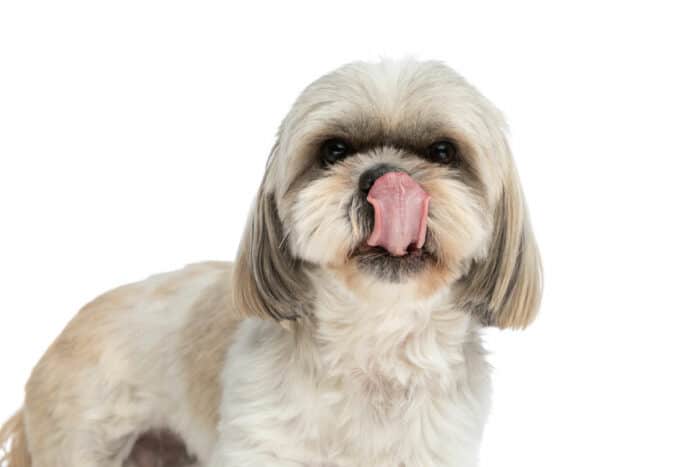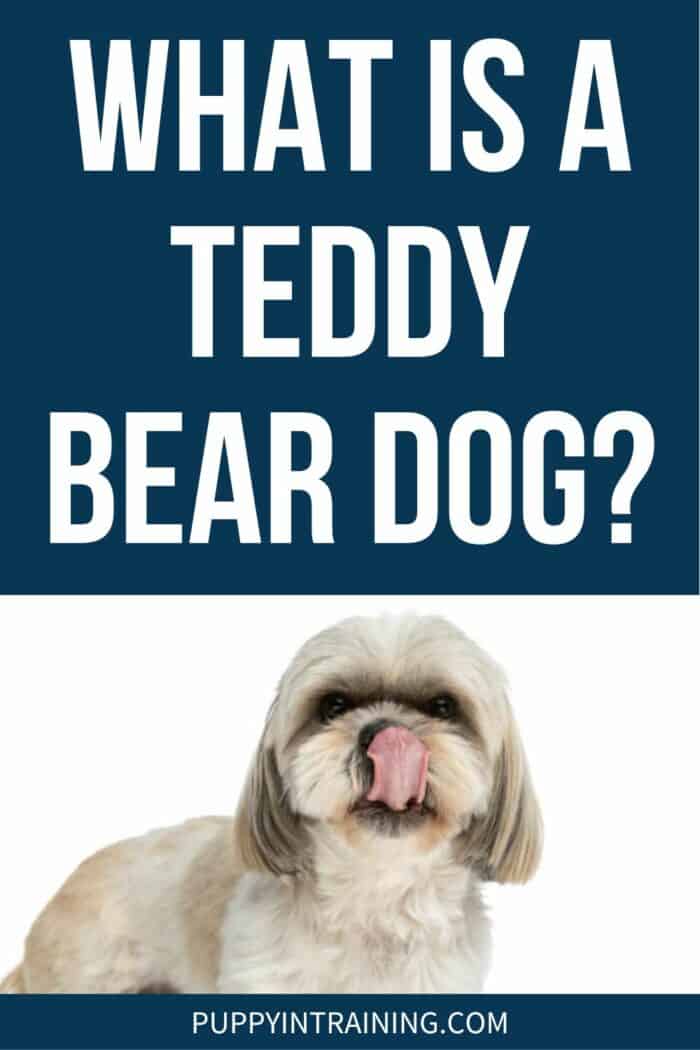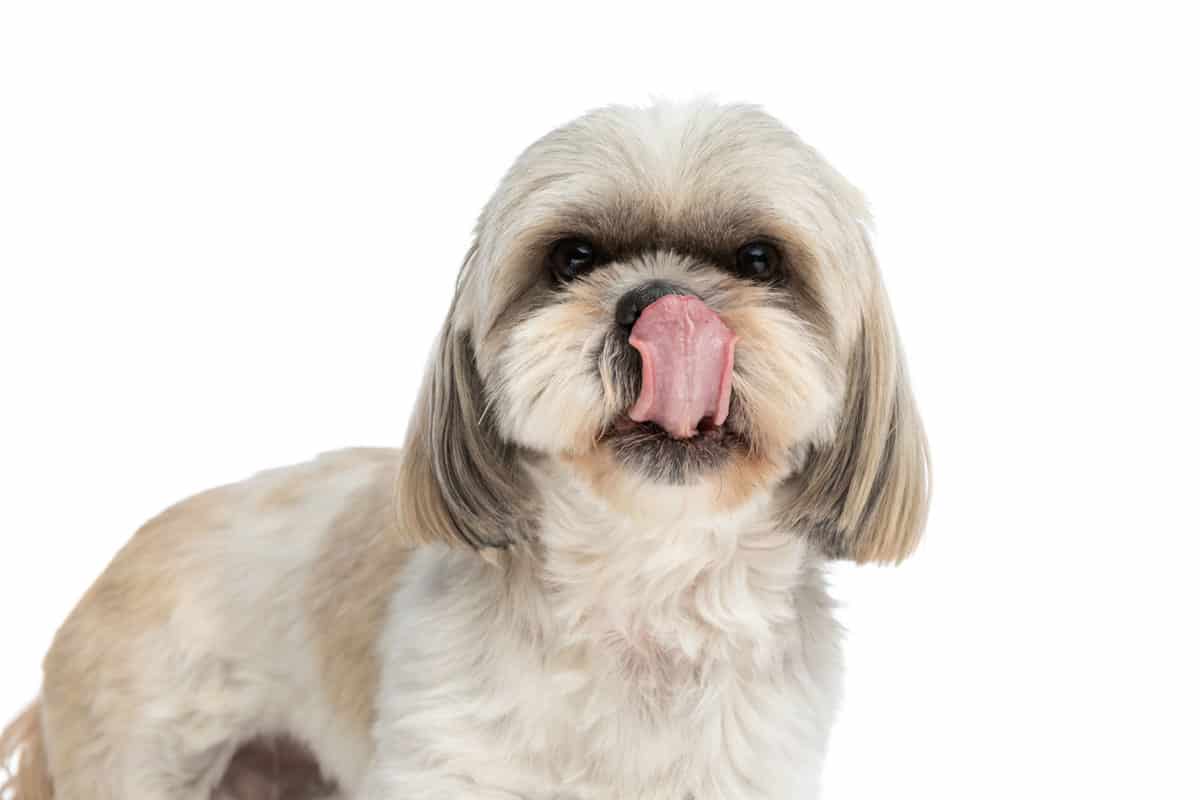This post may contain affiliate links. We may earn money or products from the companies mentioned in this post.
If you are looking for a dog that will fit into almost any lifestyle, demand cuddles from you, and look adorable while doing it, then you may have asked at some point: what is a Teddy Bear puppy?
True to their adorable-sounding name, Teddy Bear dogs are a hybrid or designer cross breed of a Shih Tzu and a Bichon Frise or, alternatively, a Shih Tzu and a Maltese.
They are also known as a Zuchon/Shichon, a Maltichon, or a Mal-Shi depending on their specific mix of breeds.
These dogs captured the hearts of celebrities and the rest of the world around the 2000s when the designer breed became truly popular.

Even though this hybrid breed has been around for a while, it is not yet recognized by the American Kennel Club or any other official breeding body.
Teddy Bear dogs are small in stature, but they make up for it with big hearts. They are fiercely loyal, loving to a fault, and capture the hearts of anyone they lay their eyes on.
Read on to learn more about what Teddy Bear dogs look like, what to expect from their personalities and temperaments, what kind of upkeep costs you can expect to incur for their health and care, and whether or not this unique breed would fit into your particular lifestyle.
What Do Teddy Bear Dogs Look Like?
Owing to the fact that the Teddy Bear dog is a mixture of breeds that are already small in size, it is no wonder that this dog is a tiny ball of fluff!
As adults, the Teddy Bear dog will stand at just 9 to 12 inches in height and weigh between 6 and 14 pounds on average. As puppies, they are palm-sized and weigh next to nothing!
It is also important to note that breeders have gone a step further and have bred teacup (also known as miniature or toy) versions of the Teddy Bear dog!
These dogs are even smaller than the normal-sized Teddy Bear dogs; they are purse-sized and rarely get larger than 10 inches and 10 pounds.
The Teddy Bear dog’s adorable name comes from the fact that they are so small and fluffy they look less like a dog and more like a stuffed teddy bear that might sit on your child’s bed.
These tiny dogs have small faces with very large, round eyes that sparkle with love and fun! Their ears are somewhat large and floppy; sometimes, you’ll notice these ears perk up, but usually, they are folded forward in little triangles!
Moving on to the rest of the Teddy Bear dog’s charming face–their little button noses stick out slightly from their faces, so they do not look like typical brachycephalic breeds like a Pug or Pekingese, even though they may have Shih Tzu parentage, as Shih Tzus are brachycephalic dogs.
See their health section for more information on this.
Owing to their parentage of the Bichon Frise, the Shih Tzu, or the Maltese, Teddy Bear dogs are hypoallergenic!
Their fur is as soft as they come and will not irritate your nose if you are allergic to dog fur! This fur is also incredibly lightweight and fluffy, which further contributes to the breed’s artificial, stuffed animal-like appearance.
Whether your Teddy Bear dog is a Maltichon, a Mal-Shi, or a Zuchon/Shichon, they can all sport a range of coat color combinations.
However, the most common and desirable Teddy Bear color is white or light cream. On top of being hypoallergenic, their coats do not shed!
Other colors that may appear in your Teddy Bear dog’s coat are:
- Black
- Darker cream
- Tan
- Brown
Because they are a designer breed, keep in mind that Teddy Bear dogs can vary in their appearance even in the same litter.
What Is The Teddy Bear Dog’s Temperament?
Can you say “fun” and “loving” enough times when looking at the Teddy Bear dog? I don’t think so!
Teddy Bear dogs have amazing temperaments and are not bothersome dogs in the slightest! They can be a calm, soothing presence, or they can be playful and fun depending on their and your mood and how diligently you’ve trained them.
These dogs are fiercely loyal, but they usually won’t pick a favorite family member. Instead, they will make an effort to protect all members of their family or “pack” with equal devotion in the face of much larger and scarier threats.
Unfortunately, I don’t think anyone told them exactly how cute and, well, non-threatening they look!
Additionally, it’s worth noting that Teddy Bear dogs are much less ‘yappy’ than other small breeds, which is a big plus if you live in an apartment or condo that has strict pet policies.
As I touched on above, Teddy bear dogs love their human families dearly, but they will also love other animals, canine or not!
Since these cute canines are not aggressive and enjoy having a large “pack,” they are excellent dogs to have if you have cats or other dogs in the home.
Expect endless contact time and cuddles. This is not a dog breed that will thrive if they are crated away from their human overnight or left for long periods of time during the day. They can even develop severe separation anxiety if they are not carefully trained.
Finally, Teddy Bear dogs are highly intelligent, even as puppies, so training from an early age is essential. Play time is a good way to ensure they are mentally and physically stimulated while enforcing their training.
What Is The Teddy Bear Dog’s Health Like?
Teddy Bear dogs are healthier than their purebred parents and other small breed dogs.
This is because their mixed-breed heritage allows them access to a more diverse range of genes instead of being stuck with a small gene pool where genetic problems become concentrated instead of diluted.
Though their parent breeds are brachycephalic, Teddy Bear dogs do not usually suffer from brachiocephalic issues. However, if their Shih Tzu parent had a particularly short snout, then this physical trait may be passed on to the mixed breed offspring.
When you are picking out your Teddy Bear puppy, look for one with a longer snout and nostrils that are not turned downwards.
It is advisable to get a first-generation Teddy Bear dog instead of one that has been bred from Teddy Bear parents.
This is because to get the ‘perfect’ teddy bear look, multiple Teddy Bear dogs will be back bred, and this will concentrate any genetic issues in the offspring.
Because these dogs are very small, they can damage their joints and suffer from dislocations or broken bones if they are handled roughly or their play time is too extreme.
Always make sure any children around them play very gently with them and do not try to pick them up.
What Is The Teddy Bear Dog’s Trainability?
Teddy Bear dogs are highly intelligent and want to please their humans. This makes them ideal dogs to train. From an early age, your Teddy Bear puppy will pick up their training easily and eagerly.
If you do not train your Teddy Bear puppy, they can become a bit of a nuisance, as they will become destructive. These dogs are also prone to separation anxiety, so without the proper training, they can become ill and even malnourished.
If your Teddy Bear dog suffers from separation anxiety, consider offering them a teddy bear of their own! A Calmeroos Puppy can act as a soothing presence for your dog, as it is big and cuddly just like you!
When training your Teddy Bear dog, remember that positive reinforcement is the key to success. They have sensitive hearts that will not take harsh discipline. However, they are so easy to train that it is a pleasure to praise them.
For best results with this particular breed, keep training to short, 15 minute intervals a couple times throughout the day. Treats, toys, and shouts of joy are the way to keep them engaged and happy.
What Are The Teddy Bear Dog’s Grooming Needs?
As I mentioned previously, Teddy Bear dogs are hypoallergenic, and they do not shed! However, this does not cut down on the amount of attention you should pay to their grooming.
For starters, their soft, fluffy coats need to be brushed regularly to avoid mats forming. They should be brushed at least two to three times a week to keep up their good looks and maintain their skin health.
Mats are painful patches of fur that knot together and grow as more fur gets pulled into the mat. As the mat grows, it pulls on the skin and leads to sores forming. It is essential that you keep your Teddy Bear’s coat mat-free.
Your Teddy Bear dog should be bathed once a month to keep their coat and skin healthy and shining! Bathing your puppy for the first time can be a bit alarming; however, it does form part of their training.
Check out my article on how to groom your puppy for the first time.
Next, your Teddy Bear dog’s teeth should be brushed once a week, and their ears should be cleaned out at the same time. Because their ears are somewhat long and floppy, they can accumulate a lot of dirt and debris fairly quickly.
You can keep your Teddy Bear dog’s coat long or trimmed short depending on your or their preferences. However, keep in mind a longer coat requires more frequent brushing.
FAQs About Teddy Bear Dogs
Are Teddy Bear dogs suited to family life?
Provided they have been socialized properly, Teddy Bear dogs love to have people around them!
With consistent training and socialization, these lovable pups can adapt to almost any lifestyle!
Whether you live alone, with a partner or child, or have a large family, your Teddy Bear dog will fit in just fine!
However, keep in mind that small children are not always aware of the proper way to treat a dog, let alone a tiny dog that looks like one of their toys they can squeeze, bite, and throw around.
If you have small children in the home, be sure to involve them in your puppy’s training! This way, they will learn with your puppy the limits of what it can do and how to treat it with respect and avoid causing it pain.
Can I have a Teddy Bear dog as a service animal?
Teddy Bear dogs are rather small and would not be ideal guide dogs.
However, they love to cuddle and have skin on fur contact. They are also highly intelligent and can sense the mood of the people around them.
This makes them an ideal candidate to be an emotional support dog for people with anxiety or panic disorders that need tactile reinforcement to help them remain balanced and ‘calm’.
Are Teddy Bear dogs expensive?
First generation Teddy Bear dogs are not generally very expensive, and neither are their upkeep costs. They are small, so they do not eat much and should be in good health for most of their lives.
However, if your Teddy Bear dog has been back bred to get its teddy bear look, then they may be more expensive, as they are seen as the ‘ideal’ Teddy Bear dogs.
What is the Teddy Bear dog’s lifespan?
As with most small breeds of dog, the Teddy Bear has a substantial lifespan for a canine.
Your lovable Teddy Bear dog will be with you for 12 to 18 years provided they are in good health!
In some cases, they can even live for up to 20 years in loving households!
Rolling Over On Teddy Bear Dogs…
What is a Teddy Bear puppy?
It’s probably just about the cutest dog you will ever see! Teddy Bear dogs are a result of breeding a Shih Tzu, Maltese, and/or, Bichon Frise together.
The resulting offspring is called a Teddy Bear, a Maltichon, a Mal-Shi, or a Zuchon/Shichon depending on its parentage.
The Teddy Bear dog generally has excellent health and will live a long and happy life devoted to their humans!
Keep in mind, though, they require a bit of upkeep as far as:
- Grooming: Teddy Bear dogs’ fur must be brushed frequently to prevent matting.
- Training: Teddy Bear dogs are highly intelligent and greatly benefit from lots of mental stimulation.
- Health Issues: Teddy Bear dogs can be brachycephalic depending on their parent breeds.
Aside from these minor caveats, these highly intelligent dogs are easily trained, love cuddles, and will remain loyal to you until the end.
They are easily motivated and eager to please for gentle words, treats, and toys!
Save To Pinterest

Top Picks For Our Puppies
- BEST PUPPY TOY
We Like: Calmeroos Puppy Toy w/ Heartbeat and Heat Packs – Perfect for new puppies. Helps ease anxiety in their new home. - BEST DOG CHEW
We Like: Bones & Chews Bully Sticks – All of our puppies love to bite, nip, and chew. We love using Bully Sticks to help divert these unwanted behaviors. - BEST DOG TREATS
We Like: Crazy Dog Train-Me Treats – We use these as our high-value treats for our guide dog puppies. - BEST FRESH DOG FOOD
We Like: The Farmer’s Dog – A couple months ago we started feeding Raven fresh dog food and she loves it! Get 50% off your first order of The Farmer’s Dog.
Check out more of our favorites on our New Puppy Checklist.
